After the record net inflows in mutual funds in 2017, 2018 started with business as usual for the European fund industry. Even as the net inflows at the beginning of 2018 were below the average of 2017 there were only a few concerns for the industry for the rest of the year.
Over the course of the year, the number of geopolitical and economic topics which might be a threat for the stock and/or bond markets increased and therefore also the uncertainty for investors. It was not therefore surprising that European investors got more cautious over the course of 2018 and started to reduce risk in their portfolios.
As a result, long-term mutual funds have faced overall net outflows of €62.3bn (£56.3bn). As a market observer it was quite surprising for me that these outflows got up to a monthly level which the European fund industry last witnessed during the eurozone crisis in 2011.
In comparison, the European ETF industry enjoyed net inflows of €700m in October and €3.9bn in November even in those months in which their active managed peers faced outflows. In fact, ETFs have enjoyed inflows in every month of 2018 so far, with the total exceeding €40bn at the end of November.
EUROPEAN INVESTORS IN CRISIS MODE
This is a flow pattern which we also witnessed during the financial crisis in 2008 and the euro crisis. With regards to this one may assume that European investors are in a crisis mode, since some markets show weak year-to-date returns.
This change in the momentum of fund flows could also lead to a change in the general behaviour of the European fund industry. After the financial crisis fund promoters in Europe consolidated their product ranges to reduce complexity and increase their overall profitability. As a result, the European fund industry enjoyed healthy net inflows since 2012 and therefore increasing revenues.
We witnessed that the number of fund closures and mergers was going down over time, while the number of fund launches stood around the same level. This pattern led to the first net increase of the number of products at the end of Q3 2018 of more than 132 net new primary funds.
If the general environment becomes negative it is to be expected that European fund promoters will return into a consolidation mode with respect to their product ranges. There are still a number of funds in Europe that have failed to meet critical mass with regards to the assets under management to be profitable for fund promoters.
ETFS WILL FLOURISH
On the other hand, I am confident that we will witness an increasing number of ETFs in Europe, since there is a high demand for these products. Additionally, we see a number of active fund promoters lining up to launch strategies as ETFs as this is a highly efficient wrapper which allows them to distribute their products to all kind of investors.
The current market environment might be the beginning of a market correction and may therefore lead to another consolidation wave within the overall European fund industry. Following the pattern of the last two market corrections, I would expect different underlying trends for the active and passive part of the industry – ie active managed funds may face again high outflows, while their passive counterparts may enjoy net inflows.
That said, inflows for ETFs during rough market conditions can’t be taken for granted, since ETFs have become very popular over the last few years and are now much more widely used than in past crisis environments, so we may also witness outflows from ETFs in an overall negative market environment.
From my point of view these flows would be rather a sign of the maturity the European ETF industry has reached (measured by the assets under management) and not a sign for a possible lack of interest or trust by the investors.
We should not forget that it would be rather normal for investors to sell their ETFs in a market crisis, since these products are designed as asset allocation tools that can be bought or sold at a transparent price in all market conditions.
– By Detlef Glow, head of Lipper EMEA research at Refinitiv
For more insight on the wealth management industry, please click on www.portfolio-adviser.com







